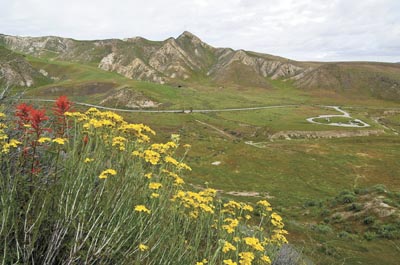San Benito County Supervisors received a disconcerting update about the Panoche Valley Solar Farm on Tuesday.
“They raped and pillaged us again,” Supervisor Jerry Muenzer said about the 26,000-acre solar project in San Benito County that promised to generate 399 megawatts of electricity for locals when it was first approved in November 2010.
County policymakers learned at their regular meeting that the renewable energy project that was met with controversy from environmental groups over its threat to endangered species that live in the valley has been cut in size yet again and the county won’t be receiving as much revenue as expected.
The facility, a project by ConEdison Development, a subsidiary energy services company of Consolidated Edison, was first reduced to 247 megawatts in May 2015. This week, policymakers found out the facility would be further cut to 130 megawatts.
“Unfortunately it looks like there’s little opportunity for the county to generate sales tax from the project at this point in its construction,” County Administrative Officer Ray Espinosa told supervisors on Tuesday. “Even though there is a lot of material out there. There’s a lot of physical, tangible material. Taxable material. Unfortunately the sales tax went to the city of San Francisco.”
ConEdison Development acquired 50 percent interest in the project from RET Capital in 2015. The company secured approximately 26,000 acres for the Panoche Valley Solar Farm, with around 3,200 acres being used for solar development. A large portion of secured land is expected to be used for conservation efforts for endangered species such as the giant kangaroo rat and blunt-nosed leopard lizard.
County Clerk-Auditor-Recorder Joe Paul Gonzalez said the county previously calculated it would receive about $5.5 million in sales tax and $13.5 million in lieu of unsecured property tax from the 247 megawatt project.
“But the project has been cut in half and we had originally calculated we’d be receiving about $2 million in sales tax at that size of a plant,” Gonzalez said. “However, because of the failure of the developer to ensure that the vendors created a mechanism here in the unincorporated county in order to report locally the sales tax, none of that sales tax money will be received in the county of San Benito directly.”
Gonzalez said the county could expect to receive around $4.2 million in lieu of unsecured property tax from the newly reduced project, but zero dollars in sales tax. Espinosa broke down the numbers further.
“I’d like to caveat that it’s approximately $100,000 to $200,000 a year versus the $800,000 to $1 million a year we’d be receiving,” Espinosa said. “That was on a downlevel scale so you’d receive a little more up front and it’ll reduce over the 20-year period.”
The Panoche Valley Solar Farm is located in the county near a major power transmission line and had an original planned capacity of 399 megawatts. The project faced legal hurdles in 2016 over environmental concerns when several groups fought the state over endangered species in the project area.
Espinosa said the downsizing of the solar project was related to a May settlement agreement between the California Department of Fish and Wildlife and the Sierra Club, Defenders of Wildlife, and Santa Clara Valley Audubon Society.
“I want to make sure the board is aware that it looks like they have or are working with these other stakeholders to reduce the project scope, as well as end all litigations in the environmental organizations against the project, ensuring continuation of the project without further delay and uncertainty,” Espinosa said.
The project site is home to several endangered species, most notably the giant kangaroo rat.
According to the Endangered Species Recovery Program at the California State University, Stanislaus, the rats are an endangered species that once spread out in the western San Joaquin Valley, but have faced shrinking habitats due to development, agricultural and otherwise.
The company is permitted to relocate, also known as translocate, a limited number of the rodent due to what’s known as an incidental take permit. However, there is little scientific evidence that giant kangaroo rats can thrive, persist and reproduce following translocation.
“Our concern stems primarily with the fact that the Panoche Valley is one of the last remaining core recovery areas for the suite of San Joaquin grassland-associated endangered species, like the giant kangaroo rat, kit fox and blunt-nosed leopard lizard,” said Pamela Flick, California representative with Defenders of Wildlife. “Prior to that development, it was all small farms and grazing lands somewhat compatible with the recovery and conservation of those species. We felt strongly the project didn’t work with that.”
Supervisors were quick to share their frustration over the project.
“I’m really upset about this whole deal,” Supervisor Anthony Botelho said.
The county gave up a lot for the solar project, but the expected amount of revenue was worth it at the time, Botelho said.
“I want our staff to work on cancelling this project and suing Edison,” he said. “For the sales tax. That money should be coming here. The point is even if the vendor is out of our county, because the equipment is in San Benito County it needs to be paid here.”
Gonzalez said the “good news” was the original development agreement language offered clarity.
“In our development agreement, the language is pretty clear that the owner shall establish a business location and tax resale account and take any other reasonable steps in an effort to maximize receipt of sales and use tax revenues for the county,” Gonzalez said, reading a portion of the agreement. “Owner shall include in its master contract and any other contract for construction language ensuring that county will receive the benefits of any sales or use tax generated by the project to the fullest extent legally permitted.”
Supervisor Muenzer said half the project was being moved down to Imperial Valley in Southern California.
“They’ve cut a deal with environmentalists so the environmentalists won’t sue them in Imperial Valley and our valley basically gets wrecked,” Muenzer said. “Panoche Valley had a beauty to it and that beauty is now gone.”
Muenzer said he agreed with Botelho.
“Whatever actions that staff needs to take, they need to be taken to address this,” he said. “[ConEdison] needs to be here answering our concerns. It’s only a half-hour jet-ride in their corporate jet to get here. They can land out in Hollister Airport. They need to be here, they need to be addressing our concerns. Basically they raped and pillaged us again. They need to be answerable for it.”
A ConEdison Development representative said Tuesday that the company wasn’t going to comment at this time.
Representatives for the Sierra Club and Santa Clara Valley Audubon Society weren’t immediately available for comment.










